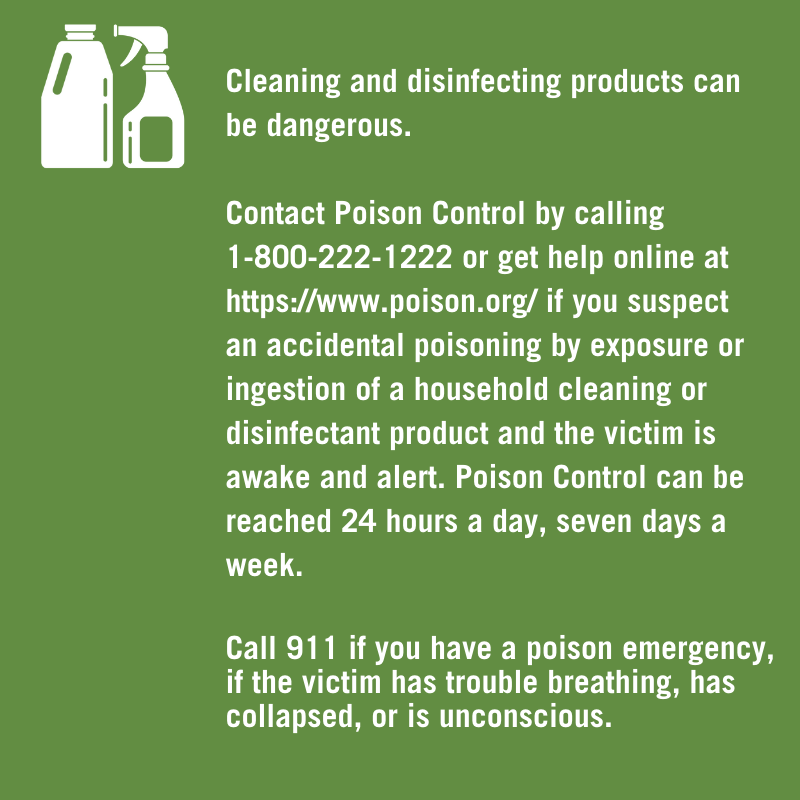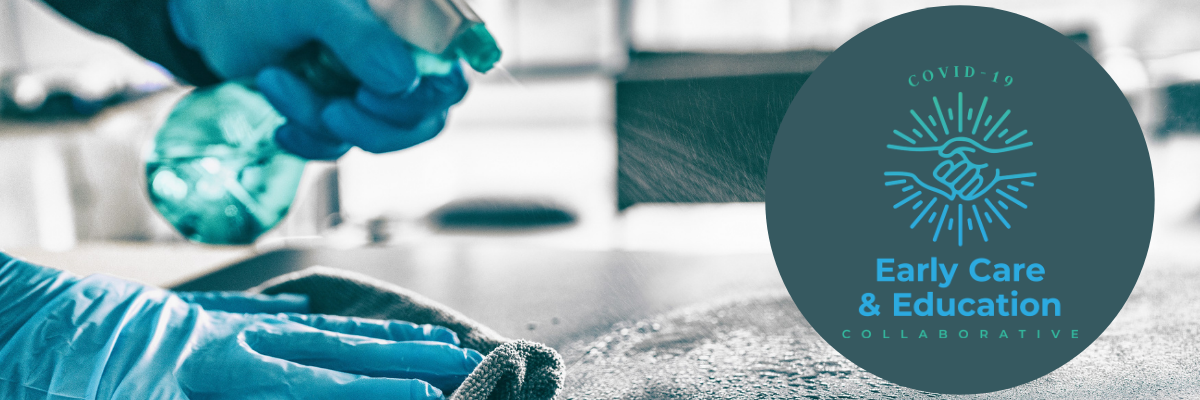Healthy Homes Guide to Cleaning and Disinfection
Para la página en español, visite Guía de limpieza y desinfección para hogares saludables.
In 2019, health officials warned of COVID-19, a new and highly infectious respiratory disease first discovered in Wuhan, China. Within weeks, the disease spread, and by March 2020 there were over 50,000 confirmed cases of COVID-19 in the United States. As of March 2021, the number of total confirmed cases in the U.S. has surpassed 29 million, with over 520,000 fatalities nationally and thousands of new cases being reported daily.
Best practices to reduce the transmission of COVID-19 emphasize avoiding close contact, practicing social distancing (by staying at least six feet apart from others who are not from your household), wearing a mask or face covering while out in public spaces, and adjusting ventilation in your home or business as the most important methods of prevention.
Federal agencies also recommend cleaning, followed by disinfection, to limit the survival of the SARS-CoV-2 virus (which causes the disease COVID-19) on surfaces.
About This Resource
Due to federal recommendations and other state and local directives, you are likely cleaning and disinfecting as part of a larger personal or professional strategy to prevent COVID-19 transmission and infection. This resource is a guide to navigate those processes safely and effectively to prevent the spread of illness.
The Healthy Homes Guide to Cleaning and Disinfection is specific to cleaning and disinfection and is not comprehensive of or a substitute for other federal and local public health guidance on other ways to prevent getting sick and spreading COVID-19.
While this resource was designed for response to COVID-19, many of the strategies and resources listed here will also be helpful for prevention of the flu and other infectious diseases.
The National Center for Healthy Housing (NCHH), in collaboration with the National Environmental Health Association (NEHA), has compiled resources and curated this page to provide comprehensive and up-to-date information on cleaning and disinfection specific to COVID-19. With the help of the content and resources collected from federal agencies, national partners, and state and local agencies and organizations, this guide is intended to serve as a guide for the general public to safely and effectively navigate the cleaning and disinfection processes in their homes and daily lives.
Sections of This Guide
Throughout this resource, you’ll find cleaning and disinfecting guidance specific to these topics:
-
General Information and Best Practices
-
Hand Hygiene and Personal Protective Equipment (PPE)
-
Products
-
Green Cleaning
-
Ventilation
-
Homes
-
Facilities
-
Reopening
Defining Cleaning and Disinfecting
To effectively and safely perform these tasks to protect yourself and your home from COVID-19, first it’s important to understand the distinction between cleaning and disinfecting.
Cleaning
Cleaning is the process of physically removing organic and inorganic material (dirt and soil), and other impurities from a surface. This process is normally accomplished using dish soap and water. While cleaning does not kill germs or viruses, routine cleaning with dish soap and water will decrease how much of the virus is on surfaces and objects, thus reducing the risk of exposure and spreading infection.
Disinfecting
Disinfecting is the process of using chemicals to reduce or eliminate pathogenic microorganisms (like bacteria and viruses) from a surface. In other words, disinfecting kills a high percentage of germs, or renders them incapable of reproducing.
How to Determine What Requires Disinfection and When Cleaning Is Sufficient
While disinfectants kill germs, they also pose health risks. For this reason, it is important to determine when disinfecting is necessary or when cleaning with soap and water is sufficient.
Disinfectants contain chemicals that can be toxic when swallowed and can cause eye and skin irritation. These chemicals can also cause lung irritation, can trigger asthma, and can be particularly dangerous to those with respiratory issues.
Additionally, the toxic chemicals in disinfectants are dangerous to children if swallowed. In a household setting, disinfectants typically should not be applied to items that children frequently touch (like toys), and especially items that children are likely to put in their mouths. For items that children frequently touch, cleaning with soap and water is usually sufficient. Considerations for cleaning and disinfecting surfaces that children frequently interact with differ in the childcare program setting. To determine what to clean and what to disinfect in these settings, please review the guidance on child care programs in the Facilities section of this resource.
In the household setting, surfaces and objects that are not frequently touched should only be cleaned with soap and water and do not require the additional step of disinfection. The process of cleaning then disinfecting is recommended on frequently touched surfaces.
Examples of frequently touched surfaces include the following:
- Tables and chairs
- Doorknobs
- Light switches
- Electronics
- Countertops
- Handles
- Sinks
- Toilets
Visit the Homes and Facilities sections for guidance on what surfaces to clean and disinfect specific to your needs.
Resource
Reopening Guidance for Cleaning and Disinfecting Public Spaces, Workplaces, Businesses, Schools, and Homes
CDC’s website will help you develop a plan and provides questions designed to walk you through deciding which surfaces and objects need normal routine cleaning and which surfaces require disinfection.
The Two-Step Process
Clean first, then disinfect. If you have determined that cleaning and disinfecting are necessary, it is important to note that cleaning and disinfecting are two separate processes. Cleaning removes dirt or soils and prepares the surface to be effectively disinfected. The cleaner the surface, the more effective the disinfection. The process of disinfection, and the removal of the SARS-CoV-2 virus, is only effective on surfaces that are free of dirt, organic and inorganic matter, and soils. Disinfecting does not clean soils from surfaces, and it is much less ineffective in their presence. Because cleaning and disinfecting are two separate processes with two separate functions, it is essential to remember to clean first, then disinfect.
Resources
Cleaning and Disinfection for Households
CDC’s interim recommendations for households during the COVID-19 pandemic, includes definitions of cleaning and disinfecting, and describes the process. [url; CDC; 2020]
Introduction, Methods, Definition of Terms
As part of a larger guideline for disinfection and sterilization in healthcare facilities, this CDC resource provides in-depth definitions of cleaning and disinfecting. [url; CDC, 2016]
Cleaning vs. Disinfecting: What’s the Difference?
The Water Quality and Health Council (WQHC) provides definitions and explains the importance of performing them in order. [url; WQHC]
Reading Labels
In addition to following the process of cleaning first, then disinfecting, it is essential to read product labels thoroughly and properly. This includes always following product label directions. Label directions are not suggestions and users must follow them to ensure the product’s safe and effective use.
Product labels will also include an EPA registration number. This number indicates that the product has been reviewed by the EPA and can be used to reference EPA’s list of disinfectants that are effective against COVID-19. Visit the Products section of this resource for guidance on selecting effective disinfectants.
When reading and following label directions, it is important to pay attention and adhere to the following key considerations:
- Contact time – Contact time (or “dwell time”) is the amount of time the surface should remain visibly wet. This ensures the product is effective.
- Signal words – Disinfectant products will have one of three signal words on their labels. These are DANGER, WARNING, or CAUTION and signal to the user the relative hazard associated with using that particular product.
- Precautionary statements – These statements will include the specific requirements on what personal protective equipment (PPE) you must wear associated with its use.
- Surface types and application methods – These will indicate what surface the product is designed to disinfect and how to properly apply to this surface.
- Storage and disposal – Labels will provide information on how to safely store and properly dispose of the products.
Resources
List N: Disinfectants for Use Against SARS-CoV-2
EPA’s website includes guidance on following label directions accompanied by its comprehensive list of approved products and their EPA registration numbers, active ingredient(s), contact time, and more. [url; EPA, 2020]
6 Steps for Safe & Effective Disinfectant Use
EPA’s one-page infographic illustrates the steps to safely and effectively use disinfectants including what to look for and reading directions on product labels. [pdf; EPA]
Cleaning and COVID-19: Read the Label
Published by AgriLife Today, this article provides guidance on reading product labels including key considerations of understanding signal words, precautionary statements, contact times, application methods, appropriate surfaces, and more. [url; AgriLife Today, 2020]
Making Sense of Disinfectant Labels: A Step-by-Step Approach
Infection Control Today’s article provides an in-depth review of the methods to effectively use a disinfectant including understanding product labels, evaluating efficacy claims, adhering to contact times, and improving compliance. [url; ICT, 2011]
Bleach
The CDC includes diluted household bleach solutions in its interim recommendations for disinfecting households. It must be noted, however, that bleach must be used with caution. Before using bleach, here are a few precautions to consider:
- Beach is corrosive and an irritant. These means it can cause harm to your skin, eyes, and lungs when used incorrectly.
- Always wear gloves, use in well-ventilated areas, and never spray the product.
- Bleach can create toxic gas when mixed with other chemicals – never mix bleach with other products.
- Always read the label and always follow all product directions and safety protocols.
- Do not apply bleach near children or people with respiratory health issues like asthma.
If you intend to use diluted bleach as a disinfectant, visit our Products section for more information on how to use bleach safely and properly.

The Healthy Homes Guide to Cleaning and Disinfection resource library was made possible through a contract between the National Environmental Health Association (NEHA) and the National Center for Healthy Housing, funded through a cooperative agreement between the Centers for Disease Control and Prevention (CDC) and the National Environmental Health Association. The contents of this resource library are solely the responsibility of the authors and do not necessarily represent the official views of the National Environmental Health Association nor the Centers for Disease Control and Prevention.
